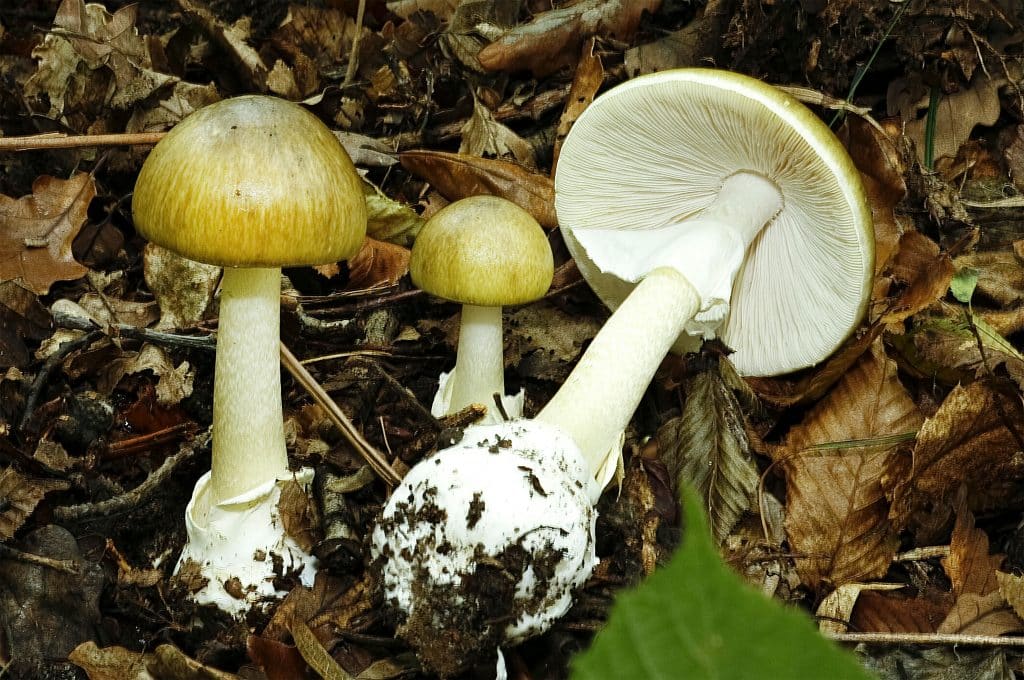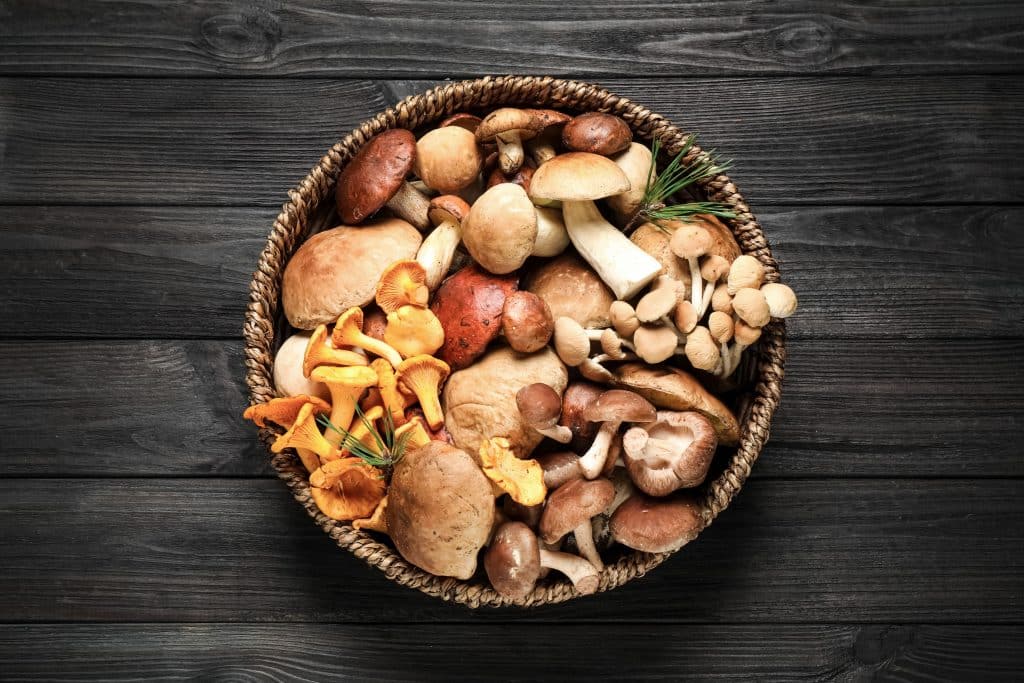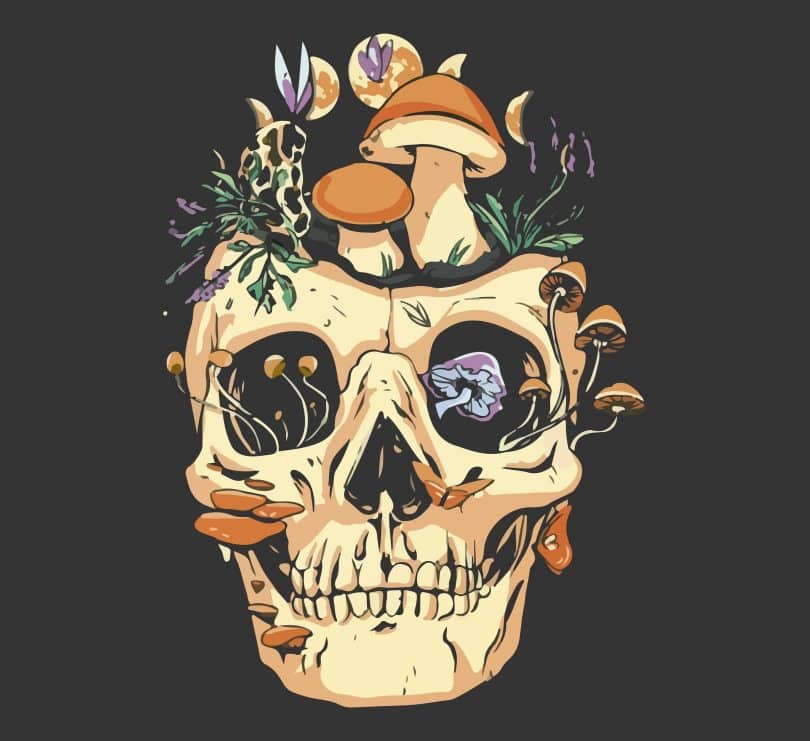Some we eat in salads, some we eat to get high. Some we’re told not to ingest, or we’ll likely get sick and die. No, that’s not meant to be a poem about mushrooms, but it does bring up some questions. Like, how dangerous are mushrooms in general? How many mushroom deaths occur in the world? And which species cause the most damage?
Mushrooms
Mushrooms, also known as toadstools, are a type of fungi that grow fruiting bodies which release spores as a means of procreation. Though they differ in how they look, they tend to have a stem, and then an umbrella-like head. They come in different colors, sizes, and contain a variety of different compounds. Some we eat regularly, some we’re told to stay away from, or we’ll die. There are about 14,000 known and documented species.
One of the interesting things common to all mushrooms, is the use of a mycelium network. This is not strictly for mushrooms, and applies to some other fungi as well. Mycelia are tiny thread-like structures, which on their own are known as hyphae, but together, are known as mycelium. The threads are produced by each spore, but remain incapable of reproduction sexually until they come together with other compatible mycelium.
The mycelium is considered monokaryotic when its non-sexual, and becomes dikaryotic, when it is sexualized, and ready to produce mushrooms. There is evidence that mycelium networks are also employed for a form of communication between plants; like in the form of releasing chemicals to warn other plants of danger.
Nice to have you with us. Check out our direct email updates with the Cannadelics Weekly Newsletter, and get yourself top notch offers on everything from cannabis buds, vapes and related paraphernalia, to edibles, smoking devices, cannabinoid compounds (like delta-8), and a ton more. Let’s all get stoned the right way!
What mushroom is the most dangerous?
Obviously right now we’re not talking about the mushrooms in your salad. We’re warned all the time that eating the wrong mushrooms can lead to horrifying consequences. But which specific mushrooms are these? And can we always easily tell them apart from mushrooms that won’t make us sick and/or die?
In this publication, we usually focus on psilocybin and Amanita muscaria mushrooms. Though they come from entirely different plant genera, both have the commonality of producing a psychoactive and hallucinogenic high when ingested. Neither type of mushroom is associated with deaths, though either can make a person sick. If you eat too many psilocybin mushrooms, you could irritate your stomach, and/or have a bad trip. And Amanita muscaria have a compound (ibotenic acid), that can make a person ill if the mushrooms are not prepared correctly.
Funny thing, the second mushroom mentioned, is actually considered a ‘poisonous mushroom.’ While psilocybin mushrooms are classified as ‘psychedelic’, all amanita mushrooms are classified as ‘poisonous.’ And though Amanita muscaria mushrooms aren’t deadly, other amanita mushrooms within the same genus, really can make a person sick enough to die. In fact, the genus amanita is home to the mushroom species most responsible for causing deaths.
Which one is it? Amanita phalloides, aka (appropriately) Death Cap, which is found in abundance in Europe. Estimates say that as many as 50% of all mushroom deaths, are from these amanita mushrooms. Though they don’t look like our spotted, high-inducing friends, they do look like other edible mushrooms like straw mushrooms and Caesar’s mushrooms.
Though Amanita muscaria are considered poisonous mushrooms, no deaths are attributed to them. The one notable – but unconfirmed – possibility of death, comes from the story of Count Achilles de Vecchj. In terms of these mushroom, with the correct preparation (boiling), they don’t need to make a person sick at all. However this method will not work for Amanita phalloides, or other amanita mushrooms with amatoxin compounds, as these deadly compounds are not affected by heat.
These deadly ‘amatoxins‘ are also found in the genera Lepiota, Galerina, and Conocybe. Together they are responsible for as many as 90-95% of mushroom poisonings and deaths worldwide. Amanita phalloides is responsible for the grand majority, possibly because they are often mistaken for edible mushrooms.

How will you know if you accidentally consumed one? Well, you’ll have to wait 6-12 hours for symptoms, which include extremely intense abdominal pain, vomiting, bloody diarrhea, and mass dehydration. Following this, the liver, kidneys, and central nervous system are affected, which eventually leads to a coma, and death occurs in more than 50% of cases.
Other deadly mushrooms
Another grouping of amanita mushrooms that can be fatal are dubbed Destroying Angels, and consist of several amanita species, most notably Amanita bisporigera. These mushrooms also resemble edible mushrooms like button mushrooms and meadow mushrooms, making it easy to simply pick the wrong one. How do you know if you’ve been poisoned. Symptoms come on within 5-24 hours, and include “vomiting, delirium, convulsions, diarrhea, liver and kidney failure”, and often death.
Another of the deadlier mushrooms out there is the Conocybe filaris, found mostly in the Pacific Northwest. While these mushrooms cause similar gastrointestinal issues within 6-24 hours, this is often misdiagnosed as food poisoning or the flu, and sometimes seems to get better. It’s a little trick the mushrooms play. Symptoms then reappear in the form of gastrointestinal distress, coupled with liver and kidney failure; which can then lead to death.
From yet another genus come the deadly Cortinarius rubellus (Deadly Webcap) and Cortinarius rubellus (Fool’s Webcap), which also have the issue of looking like some varieties of edible mushrooms. Unlike the entries above, these mushrooms contain the poisonous mycotoxin orellanin. This compound brings on flu-like symptoms, and takes much longer than the above-mentioned shrooms, to really do its dirty work. It can take 2 days to a couple weeks to even show symptoms, which makes it harder to connect the sickness to the mushrooms. It goes on to cause kidney failure, and if untreated, death.
Representing for the galerina genus, are several mushroom species that cause deaths, including one known as Autumn Skullcap – Galerina marginata; which is found in the Northern Hemisphere and Australia. Now we’re back to an amatoxin mushroom. Though its not often confused with edible mushrooms, it sometimes is confused for psilocybin mushrooms. Similar to the others, it leads to diarrhea, vomiting, and liver damage, as well as hypothermia. If untreated, the person might die.
The Deadly Dapperling is also one to be wary of, going by the official name Lepiota brunneoincarnata. Also an amatoxin mushroom found predominantly in Europe and parts of Asia, it gets confused with edible mushrooms, though related poisonings aren’t very common. Like most others, it has grave effects on the liver, and if not treated quickly, can result in death.

Another example of a non-amatoxin mushroom is Podostroma cornu-damae, found in parts of Asia. Though its not terribly common, its effects are quite severe. The trichothecene mycotoxins within can lead to multiple organ failure, along with abdominal pain, skin peeling, hair coming out, low blood pressure, and necrosis of the liver, along with full kidney failure. And death.
How many mushroom deaths occur?
We know some mushrooms are high in nutrients, and super good for us. We also know the wrong ones can kill us, and that a large majority of mushroom deaths are due to amatoxins. But how often does this occur? And how many people get sick without dying? Here’s a look at some information on the general incidence of death and sickness by mushrooms.
In the US, poison control centers have been keeping track of mushroom poisoning cases for over 30 years in the The National Poison Data System (NPDS). In one study from 2018, called Mushroom poisoning epidemiology in the United States, investigators looked at the years 1999-2016. According to results, there were 133,700 cases in that time; most all were intentional ingestion (83%), and most caused at most minor harm only (86%). About 704 of the cases did result in major harm. Of the 52 deaths, most were from cyclopeptide mushrooms which contain amatoxins (68-89%). The main issue across poisonings was the misidentification of mushrooms.
From China, the report Epidemiological analysis of wild mushroom poisoning in Zhejiang province, China, 2016–2018, was published in 2021, and focuses on just the one province. It found that there were 429 mushroom poisoning cases during those years in that location. Of those, 84 people required hospitalization, and two deaths occurred. The study pointed out what the above descriptions already showed, that digestive symptoms were found across the board.
France is another country which has reported a good bit on mushroom poisonings. In a Food safety News article from early October 2022, it said that in just one month up to that point, there were 60 mushroom poisonings. This seems to be a yearly occurrence in France, specifically in the latter half of the year. In 2021, from July to December, there were 1,269 mushroom poisonings according to poison control centers. Out of these, there were 41 extreme cases and four deaths. During the same months in 2020, 1,300 incidences, with 29 severe cases, and five deaths.
These are just a few examples. They show three important things: that misidentifying mushrooms is the main reason for issues; that there are plenty of cases yearly of mushroom poisoning all over the world; and that though sickness can be severe, and possibly lead to life-long complications by damaging organs, that death (luckily) only occurs a small percentage of the time. Even so, none of it sounds like a good time.

Conclusion
There are so many ways to get hurt and die in life. Mushroom deaths are certainly one you can avoid. Mushrooms can be great to eat, and get high off, but you have to know what you’re doing. It should be remembered that many mushrooms are dangerous, and often masquerade as edible or psychedelic mushrooms. Be careful, know your stuff, and enjoy the ones meant to be enjoyed. If you’re unsure of a mushroom, best to err on the side of caution, and pass it over for something else.
Welcome all! Thanks for joining us today at Cannadelics.com; a news site for independent reporting on the cannabis and psychedelics fields. Hang out with us on-the-regular to stay on-top of important stories; and subscribe to our Cannadelics Weekly Newsletter, to ensure you never miss a single thing.









